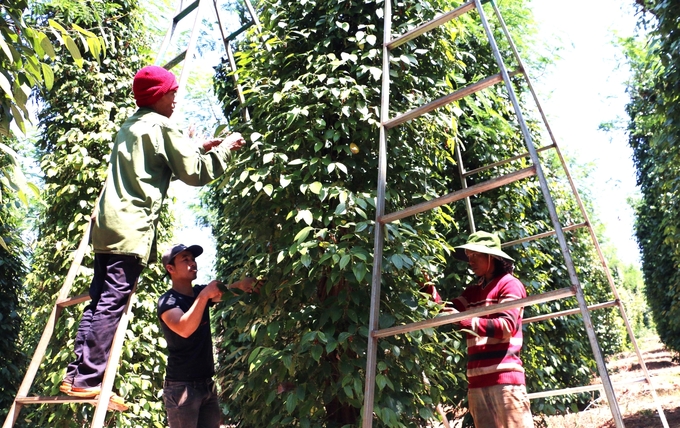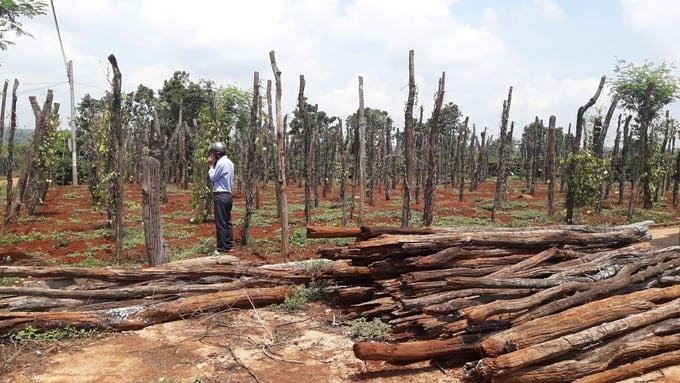November 26, 2025 | 14:35 GMT +7
November 26, 2025 | 14:35 GMT +7
Hotline: 0913.378.918
November 26, 2025 | 14:35 GMT +7
Hotline: 0913.378.918

In the past, pepper plants provided farmers in the two districts of Chu Se and Chu Puh (Gia Lai) with staggering incomes. Photo: DL.
Chu Se district in Gia Lai province features vast, flat red basalt soil, with weather and climate conditions well-suited for pepper cultivation.
Seizing this opportunity, many local experienced farmers invested their own money and ventured as far as Loc Ninh, or even further, to find high-quality seeds and learn cultivation techniques. From there, the first pepper vines were brought back and planted in the fertile red soil of what are now the two districts of Chu Se and Chu Puh.
By 2010-2012, pepper prices surged, generating significant income for local farmers. During this time, numerous "pepper kings" emerged, each cultivating dozens of hectares of pepper.
Attracted by the profits from these pepper gardens, many farmers rushed to plant pepper, even willing to uproot coffee plantations to make way for expansive pepper fields. Consequently, the area dedicated to pepper cultivation skyrocketed.

Pepper gardens scorched and dried out after the outbreak of disease. Photo: DL.
In pursuit of immediate profit, many pepper farmers expanded their cultivation by any means necessary. They purchased seeds of unclear origin, employed various techniques, and indiscriminately used chemical fertilizers and pesticides, all in hopes of achieving the highest yields.
However, by 2014-2015, some pepper gardens began to show yellowing leaves and root rot. A disease likened to "pepper cancer" decimated much of the pepper cultivation in the area. Once-thriving pepper gardens were left with only bare poles and sparse, withered vines clinging to them.
The vast pepper fields of Chu Se and Chu Puh, once famous for their "black gold", were officially devastated. All that remained were endless sorrows from the overwhelming debts faced by the garden owners.
During the peak of pepper cultivation, most families growing pepper mortgaged their land and homes to borrow money from banks, hoping to transform their lives with the "black gold". However, later on, the community learned a painful lesson about not heeding the advice of authorities and relevant agencies.
Translated by Phuong Linh

(VAN) Thanh Hoa province has substantial potential to supply carbon credits, opening opportunities for green economic development, enhancing agriculture and forestry value.
/2025/11/25/1741-0-nongnghiep-221736.jpg)
(VAN) The application of AI helps identify emission sources and assess air pollution developments, thereby supporting management agencies in issuing timely and appropriate control policies.

(VAN) Viet Nam will develop its carbon market not only by prioritizing transaction volumes but also by transitioning to a low-emission economy.
/2025/11/25/3413-1-171953_261.jpg)
(VAN) Experts from the Vietnam Academy of Science and Technology have conducted surveys to identify the causes of landslides in Lam Dong province and propose natural disaster prevention solutions.

(VAN) The HNT reservoir operation support system, developed by WeatherPlus in collaboration with Kyushu Electric Power, enables real-time rainfall forecasting, inflow forecasting, and flood-release simulations.

(VAN) Dr. Cao Duc Phat stated that the localization of early natural disaster warning technologies will help meet practical requirements and create favorable conditions for domestic research institutions and businesses to develop.

(VAN) In addition to improving early-warning technologies, there is a need for software that can guide response actions, track community evacuations, and manage safe zones through digital mapping.